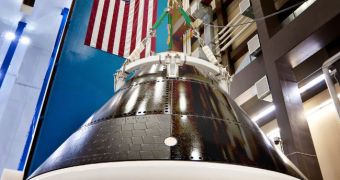Officials at prime contractor Lockheed Martin announce that engineering teams at the Denver, Colorado-based Waterton space systems facility have finished assembling the first flight-worthy Orion Multi Purpose Crew Vehicle.
With this tremendous milestone achieved, the company is now ready to move further to the next stage of the construction process, which is aimed at assessing crew safety. The Orion capsule will be put through a severe series of tests in order to determine it can carry humans to space.
Initially, this capsule was part of the Bush-era Project Constellation, which sought to put humans back on the Moon by 2020. In addition to the spacecraft, the Project also included the ARES I and V delivery systems, the Altair lunar lander and the Earth-departure stage (EDS) orbital motor.
This endeavor has since been canceled by US President Barack Obama. However, due to policies preventing the untimely termination of worthy contracts, Lockheed was asked to continue work on the capsule until funding ran out.
Through the NASA Authorization Act of 2010, the Orion Crew Exploration Vehicle was renamed the Multi Purpose Crew Vehicle (MPCV). The latter is a stripped down version of the former.
“The first Orion crew module built to spaceflight specifications is complete. Orion will soon be integrated with the launch abort system test article prior to undergoing acoustic, vibration and modal testing in Denver,” Lockheed spokeswoman Linda Singleton told Universe Today in an interview.
The official also added that the testing phase will most likely last for a few months. The spacecraft will be tested in a series of configurations, and with a variety of auxiliary components – including the Launch Abort System (LAS) – installed.
Lockheed representatives say that the purpose of the LAS is to fire its engines in case of an emergency, separating the Orion from its delivery system, and whisking it away to safety. This would come in very handy in case something went horribly wrong with the carrier rocket.
After tests are completed in Denver, the crew capsule will be delivered to the NASA Langley Research Center's new Hydro Impact Basin facility, where water landings will be simulated. The transfer is expected to take place in early 2012.
“The NASA and Lockheed Martin teams hope to achieve Orion/MPCV initial crewed operations by 2016. We are aiming for an initial unmanned orbital test flight in 2013,” Singleton concluded.

 14 DAY TRIAL //
14 DAY TRIAL //